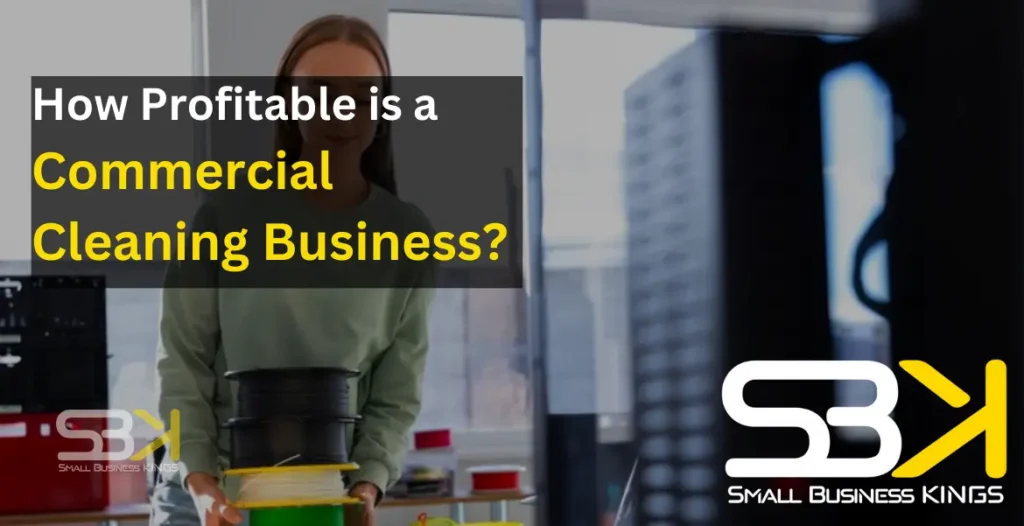Commercial cleaning businesses have significant earning potential, driven by consistent demand from various industries. The sector’s profitability is influenced by factors such as market competition, service diversification, and operational efficiency. Effective management, strategic marketing, and high-quality service delivery are crucial for maximizing earnings.
A well-planned and executed commercial cleaning business can generate substantial revenue and provide a strong return on investment. The industry’s growth prospects are further enhanced by the increasing need for specialized cleaning services. With careful planning and execution, entrepreneurs can capitalize on this lucrative business opportunity. By understanding key success factors, businesses can thrive in this dynamic market.
What Makes Commercial Cleaning Profitable?
The cleaning industry is expected to grow by 6% annually, with commercial cleaning playing a key role in this expansion. Businesses, whether offices or retail stores, constantly require a clean environment. This ongoing demand ensures a steady revenue stream. Including this insight in your commercial cleaning business plan will help you forecast growth and identify reliable opportunities in the market.
Commercial Cleaning Business Profit Margin
Profit margins for commercial cleaning services generally fall within the 10% to 30% range, contingent upon operational streamlining and pricing methodologies. Let’s look at some real numbers:
- A small commercial cleaning business with $100,000 in annual revenue can expect a profit of $10,000 to $30,000.
- Larger companies earning $500,000 annually may see profits of $50,000 to $100,000.
Profit margins vary based on operational efficiency and market factors. These margins are higher compared to residential cleaning services, where profit margins usually hover around 5% to 15%.
How Does a Cleaning Business Make Money and Stay Profitable?
A cleaning business generates income primarily through service fees charged for cleaning contracts. These can be either recurring or one-time jobs, and are influenced by factors like the size of the facility, frequency of service, and any specialized cleaning needs.
Additionally, businesses can increase revenue by offering specialized services like carpet cleaning, window washing, or disinfection. Long-term contracts with clients provide a stable and predictable income, allowing the business to plan and grow efficiently.
Key Factors Affecting Profitability
Market Demand for Commercial Cleaning
Industries like healthcare, hospitality, and retail require frequent and thorough cleaning. The global commercial cleaning services market was valued at approximately $343.34 billion in 2022, according to a report by Research and Markets.
The same report projects that the market will reach $555 billion by 2030, driven by increasing hygiene awareness and demand for professional cleaning services. Businesses are investing more in outsourced cleaning solutions to ensure compliance and maintain a safe environment for employees and customers.
Operational Costs in the Cleaning Business
To maintain healthy profit margins, it’s essential to manage your costs effectively. Here’s a breakdown of the key elements that contribute to commercial cleaning business cost, helping you keep expenses in check while maximizing profitability.
- Labor Costs
Labor accounts for 50% to 70% of total expenses. Offering competitive wages ensures you attract and retain skilled employees, which directly impacts service quality.
- Equipment and Supplies
Initial investments in industrial-grade equipment like vacuums and floor polishers can cost around $5,000 to $10,000, but these tools often last for years, reducing long-term costs.
Commercial Cleaning Service Pricing Strategies
Pricing strategies play a pivotal role in determining business triumph or failure. On average, commercial cleaning services charge between $20 and $50 per hour. For larger spaces, businesses might charge $0.10 to $0.50 per square foot. Rates can vary depending on the client’s needs and market competition.
Revenue Streams in Commercial Cleaning
Recurring Contracts vs. One-Time Jobs
Most commercial cleaning companies rely on recurring contracts for steady income. A single long-term contract with a client can bring in $1,000 to $5,000 per month, depending on the size of the facility. The revenue can differ based on service frequency and scope.
In contrast, one-time jobs, like post-construction cleanups, can bring in $500 to $5,000 per project but lack consistency.
Specialized Cleaning Services
Offering specialized services such as window washing, carpet cleaning, or disinfection can increase your revenue by 20% to 30%. This focused approach allows you to explore types of cleaning businesses and cater to niche markets, positioning your company as a one-stop provider for a wide range of cleaning solutions. Expanding your service offerings can also help you attract high-value clients who require comprehensive cleaning services.
Profitability Comparison
Commercial vs. Residential Cleaning Profitability
Commercial cleaning businesses generally generate higher revenue than residential ones. A residential cleaning business might earn around $50,000 annually, whereas a commercial cleaning business could easily surpass $100,000. Earnings can differ based on the size and type of clients.
Moreover, commercial clients often sign long-term contracts, ensuring consistent income. This highlights the commercial cleaning business profit potential, making it a lucrative and stable industry for entrepreneurs.
Growth Opportunities in the Industry
Expansion into Niche Markets
Niche markets like medical cleaning or industrial cleaning offer opportunities to charge premium rates. For example, cleaning in healthcare facilities can command rates of $0.15 to $0.75 per square foot due to the specialized nature of the job.
Long-Term Contracts
Securing long-term contracts ensures financial stability. Contracts lasting 12 to 24 months can guarantee consistent monthly revenue, reducing the need to constantly seek new clients.
How to Calculate Total Margin and Profit?
To understand your business’s financial health, you’ll need to calculate both your gross and net profit margins. Here’s how:
- Calculate Revenue
- Example: If you clean 10 offices monthly, each paying $2,000, your monthly revenue is $20,000. Actual figures will vary by contract terms.
- Determine Direct Costs (Labor, supplies, etc.)
- Labor: $8,000
- Supplies: $2,000
- Total Direct Costs: $10,000
These costs may differ based on supplier rates and local wages.
- Calculate Gross Profit Margin
- The Gross Profit is determined by deducting Direct Expenses from Sales: $20,000 – $10,000 = $10,000.
- The gross margin ratio is 50%, calculated as ($10,000 / $20,000) * 100.
- Net Profit Margin
- After deducting overhead costs like marketing, insurance, and taxes, if your net income is $5,000, the net profit margin would be ($5,000 / $20,000) * 100 = 25%. Margins can fluctuate based on overhead expenses.
How to Maximize Profits?
Client Retention Strategies for Cleaners
The financial benefits of client retention far outweigh the expenses associated with acquiring new customers. Encourage long-term partnerships by offering loyalty incentives or contract discounts. Satisfied clients often refer others, which can save you thousands in marketing expenses. Retaining clients is a proven strategy to scale your cleaning business for more profit.
Efficiency in Cleaning Operations
Investing in automation tools like scheduling software and inventory management systems can significantly reduce time wastage, allowing you to take on more clients without increasing costs. By streamlining administrative tasks, you can redirect resources to high-value activities like customer service and business development. This optimized operational framework enables scalable growth.
Common Challenges and Solutions
- High Competition
While the cleaning industry faces saturation, exceptional service can separate you. Boost your digital credibility with a strong online presence and client endorsements.
- Managing Operational Costs
Review your expenses regularly. For instance, bulk purchasing of supplies could save you 10% to 15% annually.
Case Studies of Successful Commercial Cleaning Businesses
Consider the story of a small cleaning business in Texas that started with just two employees. Within three years, they grew to a team of 20 and generated $500,000 annually, thanks to strategic marketing and securing long-term contracts.
This remarkable expansion was fueled by a focus on exceptional customer service, resulting in a 95% client retention rate and numerous referrals. Today, the company continues to thrive, serving as a model for scalable and sustainable growth in the commercial cleaning industry.
Financial Health of Cleaning Businesses
Understanding Revenue vs. Profit
Revenue is simply your total income, but profit is what truly matters. Always aim to maintain a profit margin of at least 20% for sustainable growth. Commercial cleaning business profit margin varies based on operational efficiency and market factors.
This critical distinction enables businesses to invest in strategic initiatives, weather financial storms, and reward stakeholders. By prioritizing profitability, you’ll build a resilient and adaptable enterprise.
Investment Return in Cleaning Services
An initial investment of $10,000 to $20,000 can yield returns within the first year if you manage your operations and marketing effectively. Returns depend on business scale and market demand. By leveraging efficient workflows, strategic partnerships, and targeted advertising, cleaning businesses can achieve remarkable ROI, often exceeding 50% annually. Scalable growth and expanded market share further amplify these returns.
Conclusion
In conclusion, a commercial cleaning business offers an excellent opportunity for profitability with the right strategies in place. From maintaining strong client relationships to controlling operational costs, there are numerous ways to maximize your earnings. By executing a well-planned business model and staying adaptable to market trends, entrepreneurs can establish a thriving and resilient commercial cleaning enterprise. Ultimately, this foundation sets the stage for long-term success.
FAQs
- How much can I expect to earn from a commercial cleaning business?
You could earn between $50,000 and $100,000 annually depending on your location, clients, and pricing strategy. - What are the main costs involved in running a cleaning business?
Major costs include labor (50% to 70% of expenses), equipment, cleaning supplies, and insurance. - How do I secure long-term contracts?
Provide exceptional service, offer competitive pricing, and maintain open communication with clients. - Is a commercial cleaning business profitable?
Yes, it can be very profitable, with steady demand and long-term contracts, often achieving profit margins of 20% or more. - Which cleaning services generate the highest revenue?
Commercial cleaning companies serving large-scale clients, like office buildings and retail centers, often yield higher profits due to long-term contracts and economies of scale.




